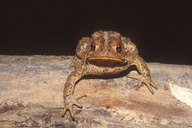|
Anaxyrus americanus (Holbrook, 1836)
American Toad, Eastern American Toad (A. a. americanus), Dwarf American Toad (A. a. charlesmithi) | family: Bufonidae genus: Anaxyrus |
 © 2001 Joyce Gross (1 of 116) |
|
|
|
Description Anaxyrus americanus has a short, stout body, with a short broad head bearing large parotoid glands and having a broadly circular snout. The back is covered with different-sized warts and the venter is granular. There are three or four pairs of dark spots down the back, each accompanied by one large wart. Eyes are prominent. The arms and legs are tubular and warty. They are generally olive in color, with a brown crest (Wright and Wright 1949). Males are roughly 54-85 mm in length. The back, sides and tympana are a dull citrine color with olive-citrine or yellow olive color on their hind legs and forelegs. The pectoral region is covered with scattered black spots, and these spots occur over the entire venter except for the throat and the center of the posterior venter. There is some apricot-yellow color across the arm insertion. The pupil is rimmed with citron yellow (Wright and Wright 1949). Females are roughly 56-110 mm in length. The back is a light brownish or buffy olive. The bigger warts are on the back, and the warts are in the centers of buffy brown colored spots. There is a stripe down the middle of the back, of a deep-olive buff color, yellow, or vinaceous-fawn, that leads from parotoid to groin. In the center of the breast, there is a dark spot (Wright and Wright 1949). Distribution and Habitat Country distribution from AmphibiaWeb's database: Canada, United States U.S. state distribution from AmphibiaWeb's database: Alabama, Arkansas, Connecticut, District of Columbia, Delaware, Georgia, Iowa, Illinois, Indiana, Kansas, Kentucky, Louisiana, Massachusetts, Maryland, Maine, Michigan, Minnesota, Missouri, Mississippi, North Carolina, North Dakota, Nebraska, New Hampshire, New Jersey, New York, Ohio, Oklahoma, Pennsylvania, Rhode Island, South Carolina, South Dakota, Tennessee, Texas, Virginia, Vermont, Wisconsin, West Virginia Canadian province distribution from AmphibiaWeb's database: Manitoba, New Brunswick, Newfoundland and Labrador, Nova Scotia, Nunavut, Ontario, Prince Edward Island, Quebec
During the periods where the toads are not reproducing, they live in within an area of approximately 100' x 100'. However, during the breeding period, they may move several thousand feet away. Life History, Abundance, Activity, and Special Behaviors Clutch size is usually 4,000-8,000 eggs, in a single string. The eggs will incubate for about 3-12 days before hatching. The tadpoles are dark, almost black. After the young toads metamorphose, they will migrate in mass numbers away from the water (Wright and Wright 1949).
References
Cook, F. R. (1984). Introduction to Canadian Amphibians and Reptiles. National Museums of Canada, Ottawa, Canada. Johnson, T. R. (1987). The Amphibians and Reptiles of Missouri. Missouri Department of Conservation, Jefferson City. Oliver, J. A. (1955). The Natural History of North American Amphibians and Reptiles. D. Van Nostrand Campany, Ltd., Canada. Schmidt, K. P. (1953). A Checklist of North American Amphibians and Reptiles. The University of Chicago Press, Chicago, Illinois. Wright, A. H. and Wright, A. A. (1949). Handbook of Frogs and Toads of the United States and Canada. Comstock Publishing Company, Inc., Ithaca, New York. Originally submitted by: Theresa Ly (first posted 2001-04-25) Edited by: Tate Tunstall, Kellie Whittaker (2012-08-15) Species Account Citation: AmphibiaWeb 2012 Anaxyrus americanus: American Toad <https://amphibiaweb.org/species/100> University of California, Berkeley, CA, USA. Accessed Jun 13, 2025.
Feedback or comments about this page.
Citation: AmphibiaWeb. 2025. <https://amphibiaweb.org> University of California, Berkeley, CA, USA. Accessed 13 Jun 2025. AmphibiaWeb's policy on data use. |




 Map of Life
Map of Life